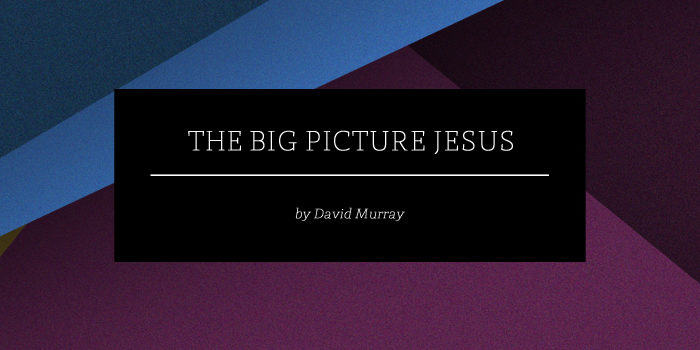
The Big Picture Jesus (David Murray)
In the recent issue of Credo Magazine, “What’s the Big Story?”, David Murray contributed an article called, “The Big Picture Jesus.” David Murray is Professor of Old Testament and Practical Theology at Puritan Reformed Theological Seminary. He was born in Glasgow, Scotland and studied for the ministry at Glasgow University and the Free Church of Scotland College (Edinburgh). He was a pastor for 12 years, first at Lochcarron Free Church of Scotland and then at Stornoway Free Church of Scotland (Continuing). From 2002 to 2007, he was Lecturer in Hebrew and Old Testament at the Free Church Seminary in Inverness. He has a Doctor of Ministry degree from Reformation International Theological Seminary for his work relating Old Testament Introduction studies to the pastoral ministry. Dr. Murray joined the faculty of Puritan Reformed Theological Seminary in 2007. He and his wife, Shona, have five children: Allan, Angus, Joni, Amy, and Scot. He blogs at Head Heart Hand. His most recent book is called, Jesus on Every Page: 10 Simple Ways to Seek and Find Christ in the Old Testament.
Here is the introduction to Murray’s article:
 Most biographies start with a person’s past. Presidential biographies not only go back to the president’s first job, or where he went to school, or even where he was born. No, the author usually starts with the president’s parents, or grandparents. In fact, usually he goes as far back as records allow.
Most biographies start with a person’s past. Presidential biographies not only go back to the president’s first job, or where he went to school, or even where he was born. No, the author usually starts with the president’s parents, or grandparents. In fact, usually he goes as far back as records allow.
Why? Why so much interest in people and places that existed and lived hundreds of years before the president?
Partly it’s because we want to trace the important influences on the president’s ancestors. We recognize that a president’s genes, characteristics, interests, personality, etc., were all shaped by his family history and even geography.
But it’s also because we want to see a plan. We want to be able to look back many years and sense the guiding hand of Providence in a person’s story, even before they were part of the story. Biographers look for decisions, events, and characters, both big and small, that demonstrate the Divine Hand preparing the way for this remarkable person’s arrival on earth. He’s looking for evidence of a plan, a pattern, or a sense of destiny that can be traced way back, through centuries, perhaps.
Presidential candidates often attempt this in their own autobiographies. They want us to connect them with the past, because they all want us to see that they were “predestined” to this, that this was part of a higher plan they had little or no say in. They’re saying, “I’m not just an accident or a coincidence! I have a story, a long and important story, that Someone else is writing for me.”
The Gospels
That’s why the first chapter of the first Gospel starts with a summary genealogy of Jesus’ ancestors. Although most people just skip over the first seventeen verses of Matthew and go straight to the baby scene, Matthew is saying: “Hey, this is important. Here’s a thumbnail sketch of this baby’s past. Now, go back, read the details, and see how this birthday is not just a combination of good luck and probability. Under God’s direction, many people, places, and events have prepared the way for this day. And if you really want to figure out who this baby is, what his purpose is, and what you should do with him, you have to go back and read about all that led up to this event.”
But not many do. Some might dip into the Psalms and Proverbs here and there, and perhaps read a couple of inspiring chapters in Isaiah from time to time, etc. But it’s like picking up the odd piece of a jigsaw puzzle, admiring it for a few minutes, then throwing it back in the box again. There’s rarely much attempt to put it all together, see the bigger picture, and identify the way that the Old Testament connects with the New, prepares for the New, sheds light on the New, and even makes sense of the New.
As this disjointed and fragmentary approach to the Bible leads to a disjointed and fragmentary spirituality, let me give you four reasons to study the Big Picture of both Testaments.
Read the rest of Murray’s article today!
What’s the Big Idea Story?
Why Biblical Theology Should Matter to Every Bible-Believing Christian
When the sixteenth-century Reformation erupted, one of the alarming dangers that became blatantly obvious to reformers like Martin Luther was the pervasiveness of biblical illiteracy among the laity. It may be tempting to think that this problem has been solved almost five hundred years later. However, in our own day biblical illiteracy in the pew continues to present a challenge. Many Christians in our post-Christian context simply are not acquainted with the storyline of the Bible and God’s actions in redemptive history from Adam to the second Adam.
With this concern in mind, the current issue of Credo Magazine strives to take a step forward, in the right direction, by emphasizing the importance of “biblical theology.” Therefore, we have brought together some of the best and brightest minds to explain what biblical theology is, why it is so important, and how each and every Christian can become a biblical theologian. Our hope in doing so is that every Christian will return to the text of Scripture with an unquenchable appetite to not only read the Bible, but comprehend God’s unfolding plan of salvation.
Contributors include: Justin Taylor, Darian Lockett, Edwards Klink III, David Murray, Stephen Dempster, James Hamilton, T. Desmond Alexander, Stephen Wellum, Peter Gentry, G. K. Beale, Graham Cole, and many others.

